Idli recipe: wondering how to make soft idli with homemade idli batter? Look no further for the perfect formula and tips for making soft idlis!
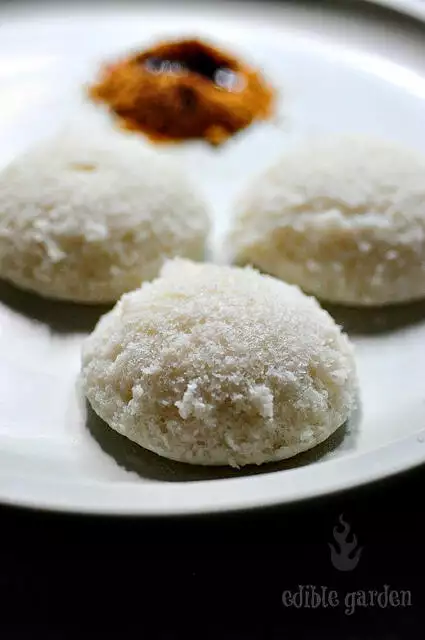
Idli and dosa is a staple breakfast for most South Indians. In my home, we always have the batter ready in our fridge and Amma is always prepared to feed multiple people for breakfast or dinner at minutes’ notice, thanks to this.
Amma has a large, old-fashioned grinder which we’ve had ever since I can remember. In my childhood, we moved houses 6 times and this grinder came with us from house to house, year by year, doing its job as expected. Ok, I will stop now, I don’t want to jinx it!
So yeah, back to idli and dosa. My maternal grand mom, as long as she was able to, oversaw the grinding of the idli-dosa batter and she did it with a hawk-eye. The help will handle the measuring and soaking and actual grinding and the heavy-lifting (quite literally) of using the stone insert in the middle of the grinder, and finally the onerous task of cleaning the thing once the batter is ground. Needless to say, except for passing by a couple of times and wondering how it would feel to dip my finger into the creamy batter, I have had nothing to do with this idli batter grinding business.
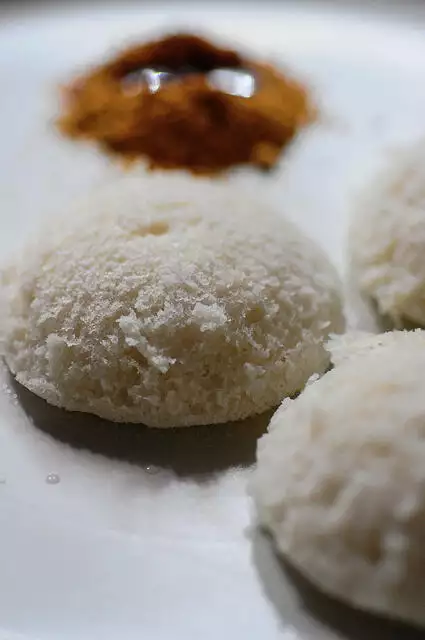
When I moved to Hyderabad for my first job, I started buying idli batter. Making idlis with store-bought batter hasn’t worked for me yet. I have tried a few times always knowing it will fail and it always has. Making dosa is easier since it’s more forgiving. But idlis are demanding. For all this, I am not even that fond of them!
Also check out rava idli, rava idli with eno, and instant oats idli. Don’t forget chutney recipes, you do need something to serve your soft and delicious idlis with.
Once I got married and moved to Singapore, I was ready to grow up and start making my own batter. I brought back a small, table-top wet grinder from back home (Trichy, to be exact) and it was a proud day I ground my first batch of idli batter.
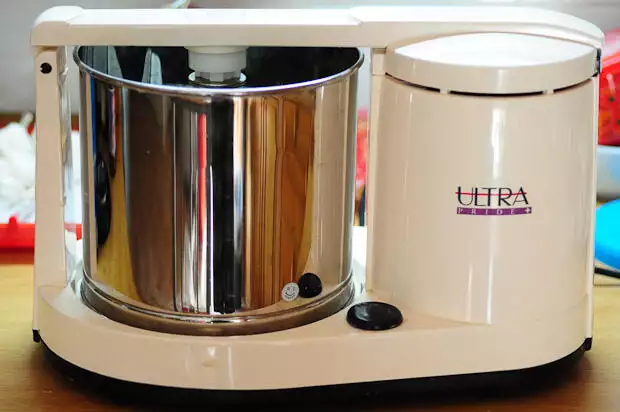
It was a disaster! The batter didn’t ferment at all and I should have taken that as a sign but it smelled fermented so I impatiently brought out the idli moulds and went the whole way. The idlis were rock hard. Dosas the next day turned out fine but the soft, pillowy idlis of my childhood had evaded me the first time and I was determined to not let that happen again.
But it did. I got it wrong about 3-4 more times. I did get marginally better at it each time but the idlis were nowhere near soft and barely edible if not dunked in litres of sambar.
I changed everything I could – the urad dal (I even brought back a kilo from Amma’s stash in Kottayam), the rice, adding salt at different times, fermenting spot, everything!
Then I realised the answer was really simple. It’s water. Yes, water. Not the type of water but the amount. I was not adding enough. It was a revelation when I realised this and since then, there has been no looking back. I make idli batter every 2 weeks and steam batches of idli and either chill them or freeze them for later use during those weekend mornings and too-tired-to-cook weeknights.
Also check out the Murugan Idli Kadai Idli Recipe.
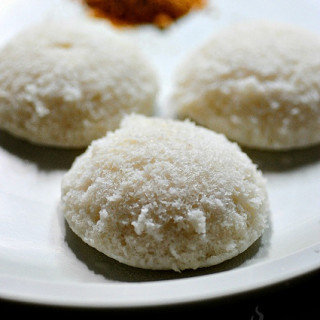
Idli Recipe: Idli Batter for Soft Idli
Ingredients
- 1 cup of whole skinned urad dal / ulutham paruppu / uzhunnu parippu
- 4 cups of idli rice
- Salt as needed
- Water as needed
- A wet grinder or powerful blender
Instructions
Step by Step Pictures to Make Idli:
- Wash the rice until the water runs clear. Soak in enough water to cover it by 3 inches and leave aside for 3-4 hours.
- Once the rice has been soaking for 2.5 to 3 hours, wash the urad dal and soak it for 30 mins or so. Amma tells me soaking urad dal for too long is not necessary and it may lose its "potency". Make sure there's enough water for it to absorb and swell - the urad dal requires more water than the rice.
- Wash and prepare your grinder. Add the soaked urad dal...
- and a generous amount of water to get it started. I usually add about 1 cup and see how that goes but this will totally depend on the quality of urad dal you use. My recurrent mistake was always not adding enough water to grind the urad dal.
- It will take about 15 mins for the urad dal to be ground smooth. When you take a little batter and rub between fingers, it should be smooth and flowy. As the urad dal grinds, it will rise and turn fluffy. This is perfect.
- Transfer the urad dal batter to a large enough container and set aside. You don't have to wipe the grinder clean of the batter. When you grind rice, it will automatically get 'cleaner'.
- In goes the soaked rice next.
- Rice doesn't need as much water as the dal so add about 1 to 1.5 cups and see if it gets thick as you grind. When rice grinds, it will absorb the water so test in between and keep adding water as you go, a little at a time. Grind rice to a smooth pate too and this takes me around 25 mins or so in my grinder.
- Once done, add this to the urad dal batter and top off with some salt. Mix gently so that the rice and dal get combined well.
- The consistency should be fluffy and the batter should fall down easily from your spoon as you mix it.
- Set aside this batter in a container that is only filled halfway with the batter to allow room for rising during fermentation.
- The urad dal would have risen to the top leaving the heavier rice batter at the bottom so you need to mix it uniformly before making idlis.
- Pour into greased (I use gingelly oil or Indian sesame oil) idli moulds and steam for 10-12 mins for super soft and spongy idlis.
Step by Step Pictures to Make Idli Batter and Soft Idli:
1. Wash the rice until the water runs clear. Soak in enough water to cover it by 3 inches and leave aside for 3-4 hours.
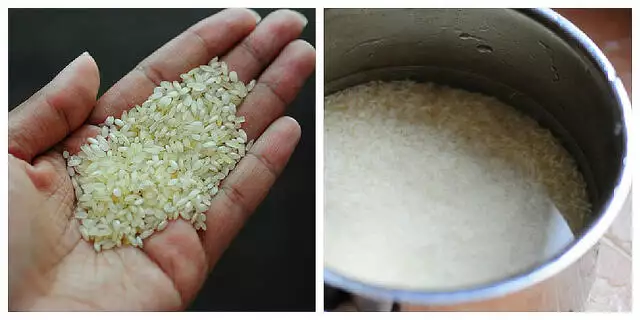
2. Once the rice has been soaking for 2.5 to 3 hours, wash the urad dal and soak it for 30 mins or so. Amma tells me soaking urad dal for too long is not necessary and it may lose its “potency”. Make sure there’s enough water for it to absorb and swell – the urad dal requires more water than the rice.
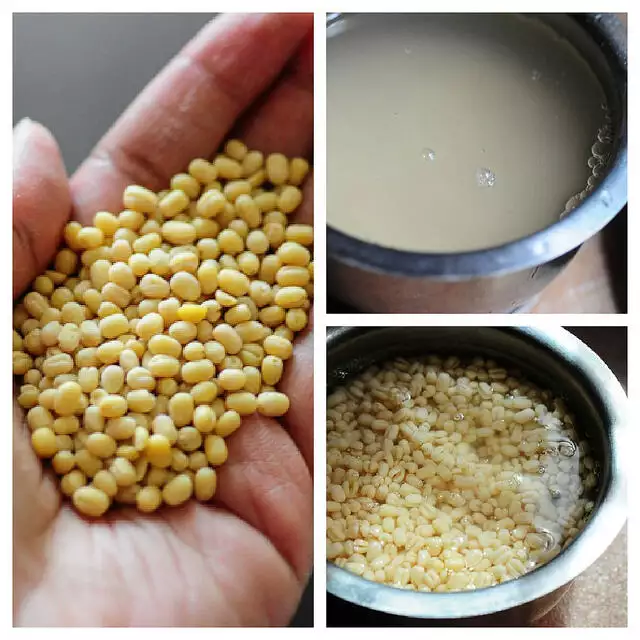
3. Wash and prepare your grinder. Add the soaked urad dal…
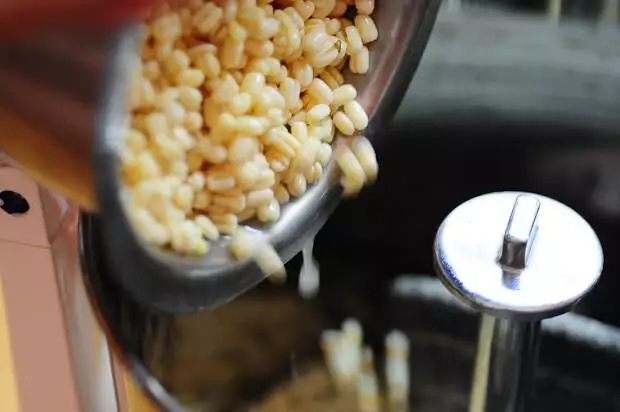
… and a generous amount of water to get it started. I usually add about 1 cup and see how that goes but this will totally depend on the quality of urad dal you use. My recurrent mistake was always not adding enough water to grind the urad dal.
It will take about 15 mins for the urad dal to be ground smooth. When you take a little batter and rub between fingers, it should be smooth and flowy. As the urad dal grinds, it will rise and turn fluffy. This is perfect.
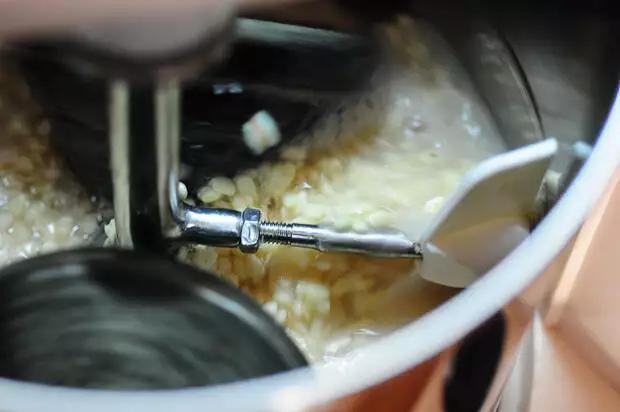
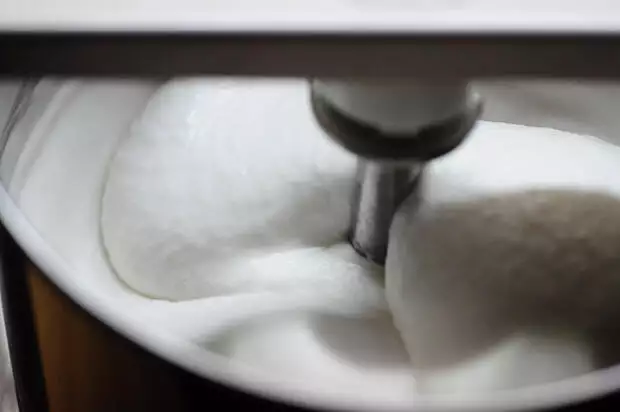
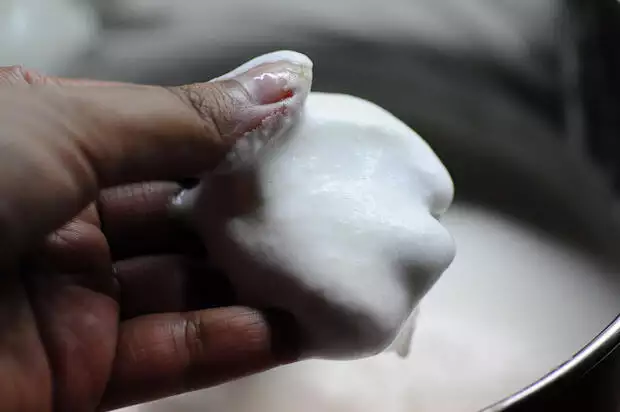
4. Transfer the urad dal batter to a large enough container and set aside. You don’t have to wipe the grinder clean of the batter. When you grind rice, it will automatically get ‘cleaner’.
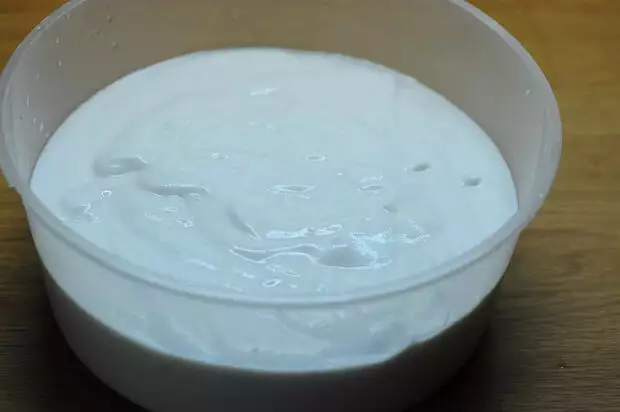
5. In goes the soaked rice next.
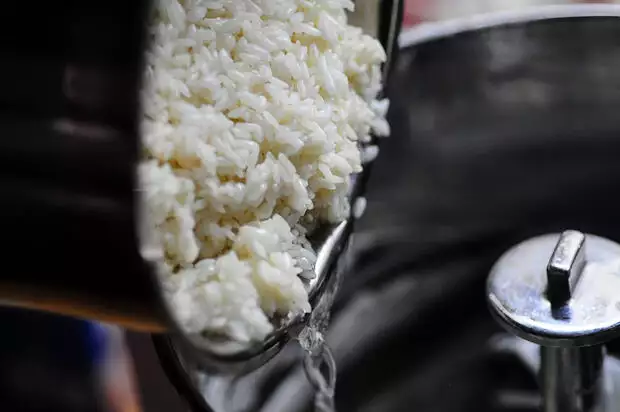
Rice doesn’t need as much water as the dal so add about 1 to 1.5 cups and see if it gets thick as you grind. When rice grinds, it will absorb the water so test in between and keep adding water as you go, a little at a time. Grind rice to a smooth pate too and this takes me around 25 mins or so in my grinder.
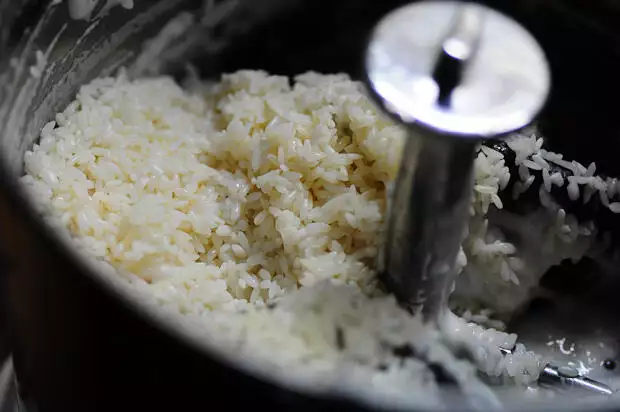
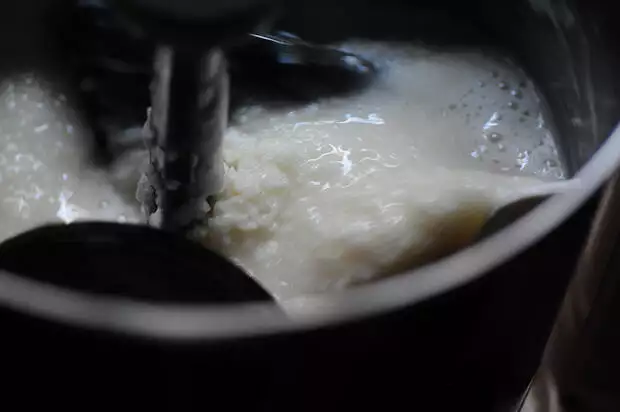
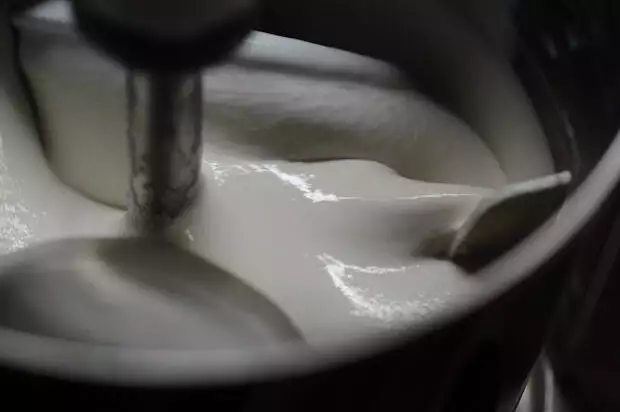
6. Once done, add this to the urad dal batter and top off with some salt. Mix gently so that the rice and dal get combined well.
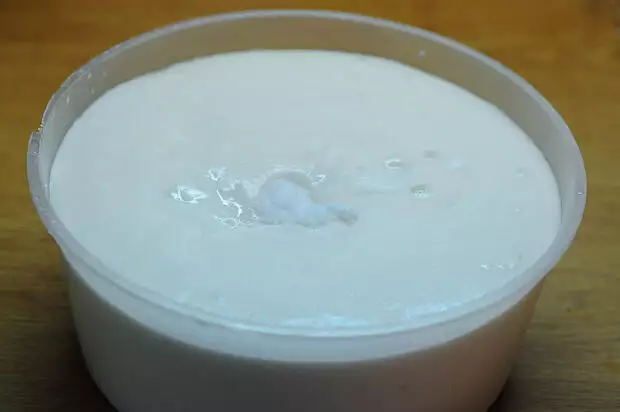
The consistency should be fluffy and the batter should fall down easily from your spoon as you mix it.
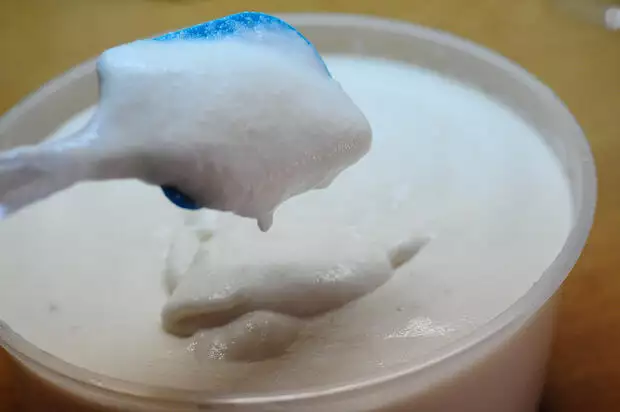
Set aside this batter in a container that is only filled halfway with the batter to allow room for rising during fermentation. Singapore is warm enough for us to leave it aside in the kitchen and it will ferment in about 6-8 hours. In colder places, you can either leave it inside the microwave (don’t turn it on!), or inside the oven with the oven light on. This is how most people I know in the US do it.
Once fermented and risen, mix very gently to combine. The urad dal would have risen to the top leaving the heavier rice batter at the bottom so you need to mix it uniformly before making idlis.
Pour into greased (I use gingelly oil) idli moulds and steam for 10-12 mins for super soft and spongy idlis.
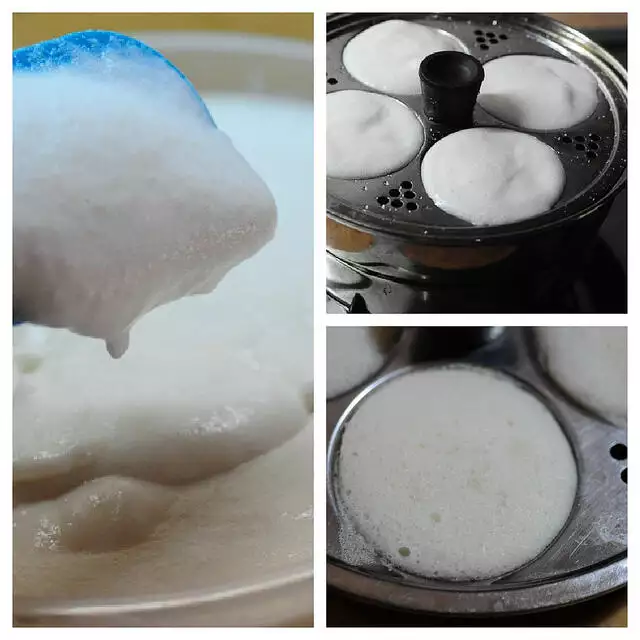
A few tips, notes, and learnings from me:
– I can’t stress the importance of adding enough water while grind the dal and rice. This is the single most important thing that separates you from soft idli.
– You can add some fenugreek seeds / methi seeds when soaking the rice. It gives a nice fragrance to the batter.
– I have tried soaking and grinding the rice and dal together (because I get immensely lazy sometimes). I got mixed results. Sometimes it worked ok and sometimes not. Again, dosa always turns out fine so if you don’t intend to make idlis, you can take this shortcut.
– Once you have scraped out all the rice batter, wash the grinder with little water and collect this in a separate bowl. After a few hours, the batter in the water will sink leaving almost-clear water on top. I add this to the batter before making dosa because for dosa we need to water down the batter anyway. My grand mom was very frugal when it came to cooking and she would do this so that we don’t even waste the batter sticking to the grinder.
– Always use a wet spoon to remove idlis from the mould and do it after the idlis have cooled down a bit.
– Once the batter is fermented and you have made idlis, store the batter in the refrigerator. You can make dosas from day 2 onwards by diluting the batter to the right pouring consistency. On day 4 and 5, if I still have batter left, I make masala kuzhi paniyaram.
– I make idlis in bulk and store in them steel containers in the chiller (if I plan to use them within the week) or in the freezer (for longer storage). Before serving, the best thing to do is to re-steam them for a quick 5 mins but if you don’t want to do that, re-heat them in the microwave with some water sprinkled on top. These have to be served immediately, otherwise they will turn hard and rubbery.
– If using a mixie or blender for grinding idli-dosa batter, remember that it won’t get you the same results as a wet grinder. Also, reduce the quantity of rice:dal and use 3:1. I use my rice cooker cup to measure, you can use any cup or tumbler as long as you use the same one to measure both rice and dal.
– If your idlis are too flat, it could be due to two reasons. One, there’s too much urad dal in the batter and two, the batter is too watery. Even if you end up adding too much urad, if your batter is thick, the idlis will be fine but too much water will create flat idlis and there’s really no way to fix this. The idlis will still turn out soft in most cases though.
– UPDATE: If any of you are using a mixie or mixer-grinder to grind your idli-dosa batter, then here’s a note from Vini who does the same in her Preethi mixer-grinder. The proportions are as I mentioned, 3:1 rice:urad dal but see how important the addition of enough water is. Read her note below. For anyone wondering “can you grind idli-dosa batter in a mixie or mixie-grinder?” Here’s your answer.
“Hey Nags,
I am glad I came across this post! I have only a mixer ever since I shifted to the US. The ladies of my house gave me several tips to make idli-dosa batter in a mixie including 3:1rice dal, mixing with hands, switching on then oven light but no one ever told me the importance of adding enough water! I always used to get ok-ok idlis and I blamed it on the mixie and was waiting to ge a grinder soon. But but I saw this awesome post and immediately soaked rice and dal..made sure I added sufficient water while grinding..the batter fermented beautifully and voila my idles where super soft just like how mom makes it back home :):) I jumped in joy when hubby told they were the best idles he had eaten since he came to the US 🙂 Thank you so much for this important tip which no other blog post on idlis stressed about. And you can tell everyone that soft idles are possible with preethi mixer grinder :)”
How do you make idli batter at home? What do you do differently and what has worked? Please leave a comment with your idli and dosa tips please!
For idli recipe and idli batter instructions in Hindi, Tamil, Telugu, Kannada, Urdu, etc please use the Google translate button in the sidebar.
If you try making idli at home using my recipe and instructions, do leave a comment and positive rating below. You can also share pictures on social media with #ediblegarden, I’d love to see them!

One foolproof method that I use is to soak Urad dal in cold water (from the fridge) and then let it soak in the fridge itself for 2-3 hours. And while grinding the urad dal, I use Ice cubes which reallymakes the batter raise wonderfully. It becomes very soft & fluffy with this method. Given this method the rice:urad dal ratio that I use is 6:1, yes you read it roght 6:1 because the batter really rises so well that you need more rice to balance it out. One tip given to me by my mother regarding Idly-Dosa batter is that when ground, the urad dal batter and the rice batter should be of equal quantities for the correct consistency of the Idly-Dosa batter. This tip has helped me a lot when my urad dal rose way behind my expectations becoming more in quantity than the rice batter. In that case, I removed the extra amount and made dosas by adding ragi flour to the extra urad dal batter.
thanks for the great tips shobhana. i didn't realise chilling the urad dal would make the idli dosa more soft and spongy. i must try that. do you add the ice cubes into the grinder as is? it won't damage the machine right? ok maybe that's a stupid question 🙂 will definitely use your tips to making soft idlis next time i make idli dosa batter. adding equal quantities is also a great tip. i do sometimes feel that i have more urad dal batter than rice batter, especially when i want to make idlis.
Thank you Shobhana! 🙂
Don't worry about the ice cubes being put directly into the grinder. If not anything else, you get to know the power of your grinder in grinding those ice cubes with the dal and rice. The chilling method was found accidentally when I couldn't grind the dal I had soaked, immediately at the time I had planned for. That's when I got worried that it might get spoilt and I kept it in the fridge. And wow, the result was a fantastic discovery 🙂
In our home, we soak the Urad Dal in Cold water and then keep it in the fridge for 2-3 hours. Also, while grinding the urad dal, I use ice cubes which really makes the urad dal batter rise very well and is fluffy like air. When this method is used, I alter the ratio of rice:urad dal as 6:1, yes 6:1 as the urad dal really rises so much that you need more proportion of rice to make the batter equal. I use Annam/Udayam Brand Udad Dal that we get here in Chennai. You may try this method to see how much more fluffy your urad dal batter becomes. A tip that my mother gave me regarding the Idly batter is that, once ground, the urad dal batter should be equal to the rice batter (which does not rise like the urad dal, hence the ground quantity of batter turn out to be the same. When this is achieved, you have the perfect batter for Idly & Dosa.
I'm newly married and learning cooking. Trying out idli for the first time. I added 1 whole urad dal and 3 idli rice. Made it in a mixie. Left it for fermenting for tomorrow. Hope it is a success.
good luck! do keep me posted 🙂
3:1 ratio for idli batter made in mixie is good. there could be so many other reasons why the idlis didn't turn out as soft as you expected. generally the mixie batter can only go so much and since i don't know how it turned out for you and what you are expecting, this issue is hard to diagnose 🙂
I made the idlis today. It came out spongy and tasted good. But somewhere hubby felt it should have become more softer. Is it because I added 3:1 instead of 4:1?
Hey stepped by your blog, really useful post… I normally preapre my Idlis after adding a wet small karcheif like cloth on the conatiner then pour the idli batter and prepare idlis
It helps in easy retrival after the idlis are baked, you just have to sprinkle water and you can transfer them pipping hot into hot case . I have noticed that idlis done like this does not become harder after it becomes cold
ah that explains it! i used to wonder why people use those cloth pieces when making idli. so it's about easy removal. i do realise my idlis are a big mangled since i don't grease the moulds uniformly. someone suggested using pam spray to grease idli moulds, which i think is a great idea
Hi, !
Love reading this description of the idli preparations. I looked at the rice held in your hand in the photo, is that rice a "sweet rice" in contrast to a jasmine or a basamati?
U seem to be using whole Urad dal. Is this washed and the black cover washed off ?? I used split urad dal. Is it good enough ? Thanks. Appu
Hey appu, split urad dal won't work as well as the whole ones. You get the skinned urad dal to buy, don't get the ones with the black skin, they are not easy to remove.
Left two comments that didn't appear….
May I nominate you for an award? Or is that too blasé? You've been blogging a long time I see 🙂
Radhika aka Dedicated Docent
I'm never able to leave a comment successfully…tried many times.
Your comment did appear 🙂
I never buy urad or toor dal in Singapore either. Those are the two standard things I bring back from India each time I go, in addition to raw rice and sesame oil.
I hope I'm not spamming you…but I still can't see my comments. May I nominate you for an award? Or it is passé?
After struggling for ages with the urud dal from Singapore, I now beg or borrow (not yet steal) my dal from India. Anyone coming to Singapore who asks me what I want- I say "urud dal and toor dal"
My idlis have been decent, but after adding the cooked rice that you suggested, they are soft as a baby's cheek 🙂
When i was searching the recipe of "Super spongy Andhra Idli" i end up reading this post. Well portrayed, a flawless writing. it's definitely helpful for those who are making paperweights under the brand name od idly. Keep up the good worlk. Appreciate it! (If possible get me the Andhra idly making recipe too)
PS: I'm a tamil guy